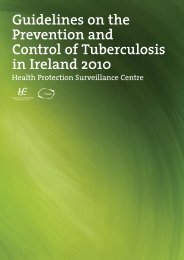Guidelines for the Early Clinical and Public Health Management of ...
Guidelines for the Early Clinical and Public Health Management of ...
Guidelines for the Early Clinical and Public Health Management of ...
You also want an ePaper? Increase the reach of your titles
YUMPU automatically turns print PDFs into web optimized ePapers that Google loves.
<strong>Guidelines</strong> <strong>for</strong> <strong>the</strong> <strong>Early</strong> <strong>Clinical</strong> <strong>and</strong> <strong>Public</strong> <strong>Health</strong> <strong>Management</strong> <strong>of</strong> Bacterial Meningitis (including Meningococcal Disease)<br />
Chapter 2. Pre-admission <strong>Management</strong><br />
Key points<br />
• A presumptive diagnosis <strong>of</strong> bacterial meningitis is a medical emergency <strong>and</strong> immediate referral to<br />
hospital is required.<br />
• Meningococcal septicaemia has a higher mortality rate than meningococcal meningitis. Septicaemia is<br />
<strong>of</strong>ten characterised by a rapidly evolving petechial or purpuric rash that does not blanch under pressure.<br />
However, in <strong>the</strong> early stage <strong>of</strong> development <strong>the</strong> rash may blanch with pressure thus resembling a viral<br />
rash, or it may be absent, or may be atypical. If present it may consist only <strong>of</strong> a few haemorrhagic spots<br />
located in a place such as <strong>the</strong> groin or feet.<br />
• Meningococcal disease may have clinical features not normally encountered in children with acute<br />
systemic self limiting febrile illnesses.<br />
• “Red flag symptoms” include confusion, leg pain, photophobia, rash <strong>and</strong> neck pain/stiffness.<br />
• <strong>Health</strong> care providers should ensure that any patient with a systemic febrile illness, particularly a child,<br />
can be reassessed without delay if <strong>the</strong>ir condition deteriorates.<br />
• Doctors should be encouraged to review <strong>the</strong> situation within 4-6 hours if early meningococcal disease<br />
cannot be ruled out at first assessment.<br />
• All GPs <strong>and</strong> advanced paramedics should have benzylpenicillin available when attending patients <strong>and</strong><br />
should be ready to administer it without delay to patients with a systemic febrile illness <strong>and</strong> a petechial<br />
or purpuric rash. Ceftriaxone or cefotaxime are suitable alternatives if available.<br />
2.1 Introduction<br />
Meningococcal disease usually presents as meningitis or septicaemia, or a combination <strong>of</strong> <strong>the</strong> two. Septicaemia, with<br />
or without meningitis, can be particularly severe <strong>and</strong> is associated with a considerably greater mortality rate than<br />
meningococcal meningitis without bloodstream infection. 8<br />
Meningococcal septicaemia can have a fulminant <strong>and</strong> rapidly fatal course. The development <strong>of</strong> signs suggestive <strong>of</strong><br />
acute sepsis <strong>and</strong>/or meningitis is a medical emergency <strong>and</strong> m<strong>and</strong>ates prompt intervention. <strong>Management</strong> priorities<br />
differ depending on <strong>the</strong> clinical presentation i.e. that <strong>of</strong> severe sepsis with or without associated meningitis, or that <strong>of</strong><br />
meningitis.<br />
Acute meningococcal disease, <strong>the</strong> most common cause <strong>of</strong> life threatening infection in healthy children <strong>and</strong> young<br />
adults, commonly presents as severe sepsis <strong>and</strong>/or meningitis. Rarely, o<strong>the</strong>r <strong>for</strong>ms <strong>of</strong> invasive meningococcal<br />
infection are encountered. The overall mortality rate <strong>for</strong> meningococcal infection typically ranges from 3-10%, but<br />
can reach as high as 20-40% in severe sepsis/meningitis (see Chapter 5 <strong>for</strong> fur<strong>the</strong>r detail). Meningococcal infection<br />
remains <strong>the</strong> most common cause <strong>of</strong> bacterial meningitis in Irel<strong>and</strong>.<br />
The speed with which meningococcal infections are recognized <strong>and</strong> treated is critical to achieving a successful<br />
outcome <strong>and</strong> clinical suspicion alone m<strong>and</strong>ates treatment. If meningococcal infection is suspected, administration<br />
<strong>of</strong> benzylpenicillin by <strong>the</strong> GP or advanced paramedic may be life-saving <strong>and</strong> is strongly recommended. Although<br />
results <strong>of</strong> studies <strong>of</strong> <strong>the</strong> benefit <strong>of</strong> pre-admission antibiotics have been inconsistent, this has variably been attributed<br />
to <strong>the</strong>ir retrospective nature <strong>and</strong> confounding factors such as illness severity (those most severely ill may be more<br />
likely to receive antibiotics). 9,10<br />
2.2 <strong>Clinical</strong> presentation <strong>of</strong> invasive meningococcal disease<br />
The most characteristic feature <strong>of</strong> meningococcal septicaemia is a haemorrhagic (i.e. petechial or purpuric) rash<br />
that does not blanch under pressure. However, a rash is not always present, particularly in <strong>the</strong> early stages. In<br />
-17-

















